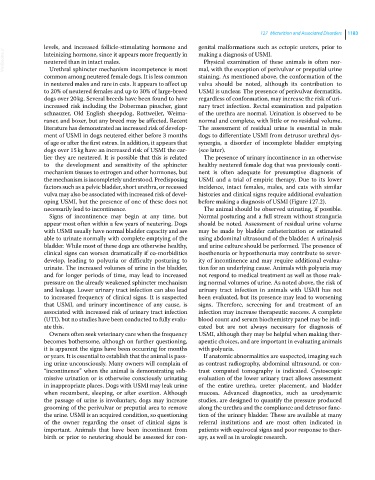Page 1245 - Clinical Small Animal Internal Medicine
P. 1245
127 Micturition and Associated Disorders 1183
levels, and increased follicle‐stimulating hormone and genital malformations such as ectopic ureters, prior to
VetBooks.ir luteinizing hormone, since it appears more frequently in making a diagnosis of USMI.
Physical examination of these animals is often nor
neutered than in intact males.
Urethral sphincter mechanism incompetence is most
staining. As mentioned above, the conformation of the
common among neutered female dogs. It is less common mal, with the exception of perivulvar or preputial urine
in neutered males and rare in cats. It appears to affect up vulva should be noted, although its contribution to
to 20% of neutered females and up to 30% of large‐breed USMI is unclear. The presence of perivulvar dermatitis,
dogs over 20 kg. Several breeds have been found to have regardless of conformation, may increase the risk of uri
increased risk including the Doberman pinscher, giant nary tract infection. Rectal examination and palpation
schnauzer, Old English sheepdog, Rottweiler, Weima of the urethra are normal. Urination is observed to be
raner, and boxer, but any breed may be affected. Recent normal and complete, with little or no residual volume.
literature has demonstrated an increased risk of develop The assessment of residual urine is essential in male
ment of USMI in dogs neutered either before 3 months dogs to differentiate USMI from detrusor urethral dys
of age or after the first estrus. In addition, it appears that synergia, a disorder of incomplete bladder emptying
dogs over 15 kg have an increased risk of USMI the ear (see later).
lier they are neutered. It is possible that this is related The presence of urinary incontinence in an otherwise
to the development and sensitivity of the sphincter healthy neutered female dog that was previously conti
mechanism tissues to estrogen and other hormones, but nent is often adequate for presumptive diagnosis of
the mechanism is incompletely understood. Predisposing USMI and a trial of empiric therapy. Due to its lower
factors such as a pelvic bladder, short urethra, or recessed incidence, intact females, males, and cats with similar
vulva may also be associated with increased risk of devel histories and clinical signs require additional evaluation
oping USMI, but the presence of one of these does not before making a diagnosis of USMI (Figure 127.2).
necessarily lead to incontinence. The animal should be observed urinating, if possible.
Signs of incontinence may begin at any time, but Normal posturing and a full stream without stranguria
appear most often within a few years of neutering. Dogs should be noted. Assessment of residual urine volume
with USMI usually have normal bladder capacity and are may be made by bladder catheterization or estimated
able to urinate normally with complete emptying of the using abdominal ultrasound of the bladder. A urinalysis
bladder. While most of these dogs are otherwise healthy, and urine culture should be performed. The presence of
clinical signs can worsen dramatically if co‐morbidities isosthenuria or hyposthenuria may contribute to sever
develop, leading to polyuria or difficulty posturing to ity of incontinence and may require additional evalua
urinate. The increased volumes of urine in the bladder, tion for an underlying cause. Animals with polyuria may
and for longer periods of time, may lead to increased not respond to medical treatment as well as those mak
pressure on the already weakened sphincter mechanism ing normal volumes of urine. As noted above, the risk of
and leakage. Lower urinary tract infection can also lead urinary tract infection in animals with USMI has not
to increased frequency of clinical signs. It is suspected been evaluated, but its presence may lead to worsening
that USMI, and urinary incontinence of any cause, is signs. Therefore, screening for and treatment of an
associated with increased risk of urinary tract infection infection may increase therapeutic success. A complete
(UTI), but no studies have been conducted to fully evalu blood count and serum biochemistry panel may be indi
ate this. cated but are not always necessary for diagnosis of
Owners often seek veterinary care when the frequency USMI, although they may be helpful when making ther
becomes bothersome, although on further questioning, apeutic choices, and are important in evaluating animals
it is apparent the signs have been occurring for months with polyuria.
or years. It is essential to establish that the animal is pass If anatomic abnormalities are suspected, imaging such
ing urine unconsciously. Many owners will complain of as contrast radiography, abdominal ultrasound, or con
“incontinence” when the animal is demonstrating sub trast computed tomography is indicated. Cystoscopic
missive urination or is otherwise consciously urinating evaluation of the lower urinary tract allows assessment
in inappropriate places. Dogs with USMI may leak urine of the entire urethra, ureter placement, and bladder
when recumbent, sleeping, or after exertion. Although mucosa. Advanced diagnostics, such as urodynamic
the passage of urine is involuntary, dogs may increase studies, are designed to quantify the pressure produced
grooming of the perivulvar or preputial area to remove along the urethra and the compliance and detrusor func
the urine. USMI is an acquired condition, so questioning tion of the urinary bladder. These are available at many
of the owner regarding the onset of clinical signs is referral institutions and are most often indicated in
important. Animals that have been incontinent from patients with equivocal signs and poor response to ther
birth or prior to neutering should be assessed for con apy, as well as in urologic research.

